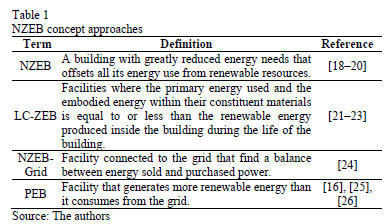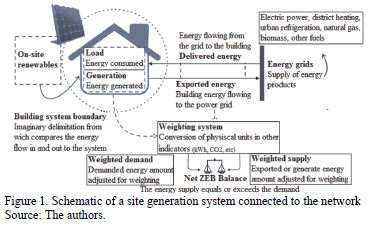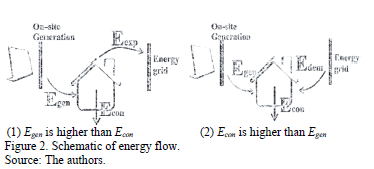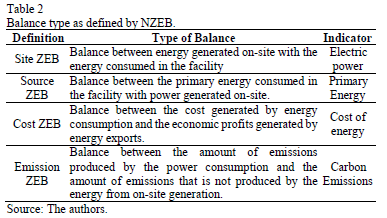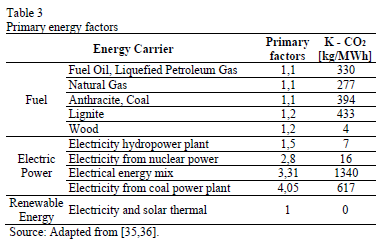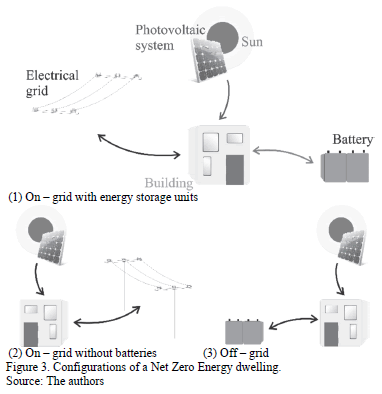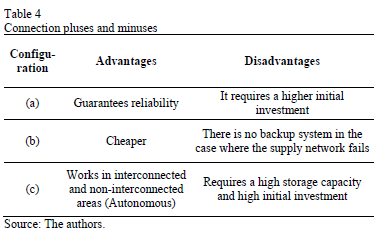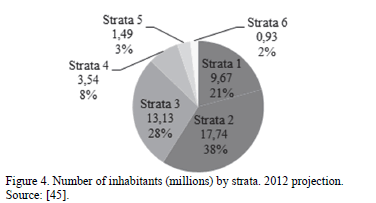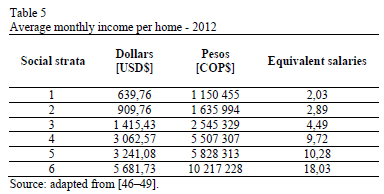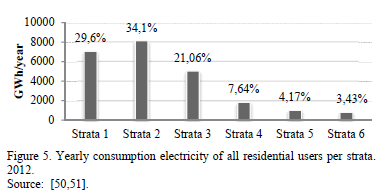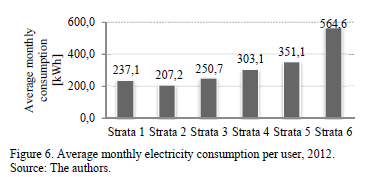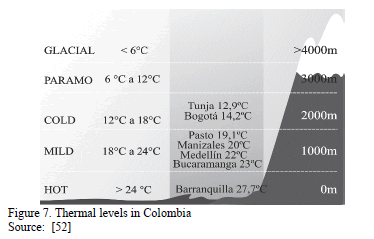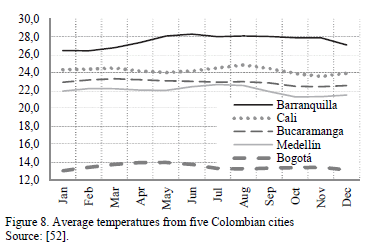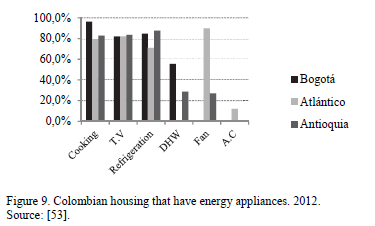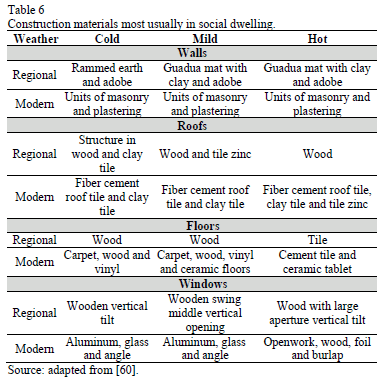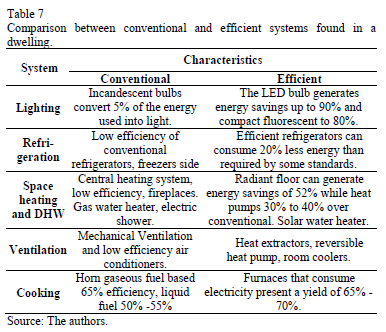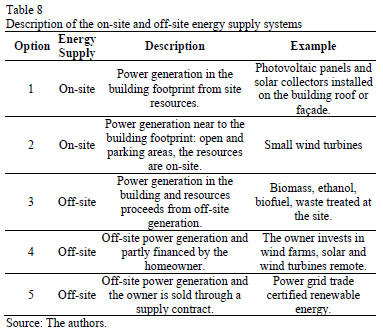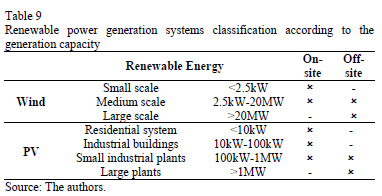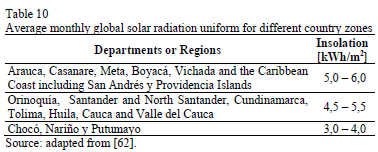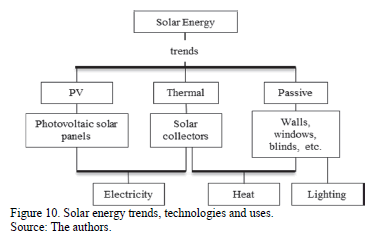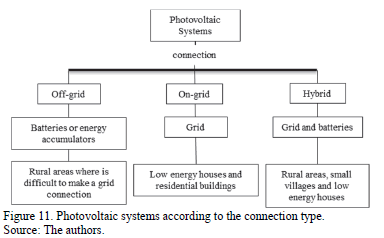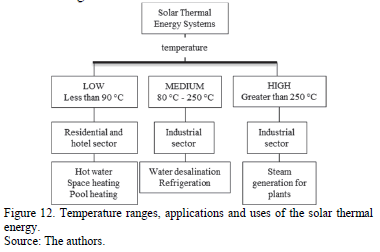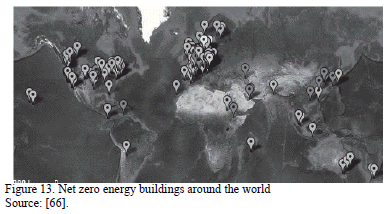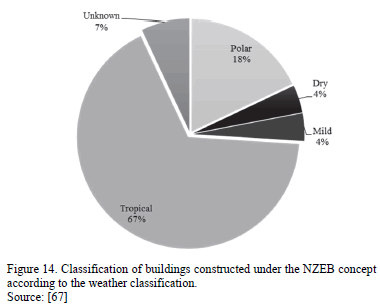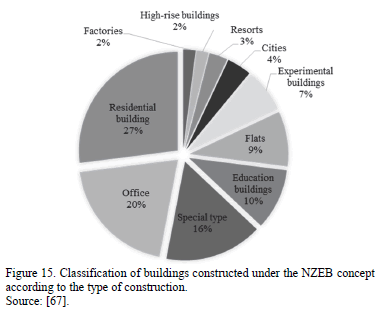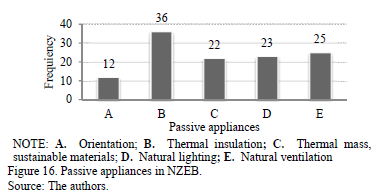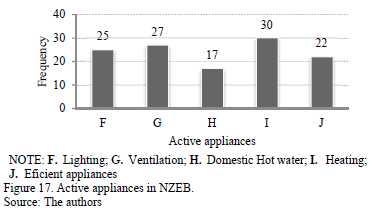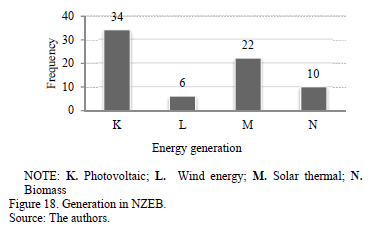Services on Demand
Journal
Article
Indicators
-
 Cited by SciELO
Cited by SciELO -
 Access statistics
Access statistics
Related links
-
 Cited by Google
Cited by Google -
 Similars in
SciELO
Similars in
SciELO -
 Similars in Google
Similars in Google
Share
DYNA
Print version ISSN 0012-7353
Dyna rev.fac.nac.minas vol.82 no.192 Medellín July/Aug. 2015
https://doi.org/10.15446/dyna.v82n192.48587
DOI: http://dx.doi.org/10.15446/dyna.v82n192.48587
Energy considerations of social dwellings in Colombia according to the NZEB concept
Consideraciones energéticas de viviendas de interés social en Colombia según el concepto NZEB
Germán Alfonso Osma-Pinto a, David Andrés Sarmiento-Nova b, Nelly Catherine Barbosa-Calderón c & Gabriel Ordóñez-Plata d
a E. de Ingenierías Eléctrica, Electrónica y de Telecomunicaciones,, Universidad Industrial de Santander, Bucaramanga, Colombia. german.osma@gmail.com
b E. de Ingenierías Eléctrica, Electrónica y de Telecomunicaciones,, Universidad Industrial de Santander, Bucaramanga, Colombia vrdeoscuro@gmail.com
c E. de Ingenierías Eléctrica, Electrónica y de Telecomunicaciones, Universidad Industrial de Santander, Bucaramanga, Colombia, ncatherine.barbosac@hotmail.com
d E. de Ingenierías Eléctrica, Electrónica y de Telecomunicaciones,, Universidad Industrial de Santander, Bucaramanga, Colombia. gaby@uis.edu.co
Received: April 29th, 2014. Received in revised form: February 17th, 2015. Accepted: July 3nd, 2015.
This work is licensed under a Creative Commons Attribution-NonCommercial-NoDerivatives 4.0 International License.

Abstract
In this paper, the characteristics and definitions of NZEBs are studied. In particular, the methods for calculating balance for each concept and methodology are analyzed in this work, taking into account the interaction of the NZEB with the energy grid, the emissions produced per energy consumption and the introduction of the primary energy concept as an indicator of balance. High-energy-efficient appliances are the main interest in this paper due to their importance and level of use in tropical regions. How these appliances can reduce energy consumption is described, as well as their impact on electrical performance being of significant benefit in Colombia. That is if they could be applied on a massive scale in projects related to Viviendas de Interés Social -VIS (social dwellings) in the long term.
Keywords: NZEB, NZEB Balance, emission, site, source, on-grid, off-grid, energy efficient appliances, passive applications.
Resumen
En el presente artículo, se estudian las características y defniciones de una construcción tipo Net Zero Energy. En particular, las formas para calcular el balance y la metodología para realizarlo, teniendo en cuenta la interacción de la construcción con la red de energía, las emisiones generadas por el consumo de energía y la introducción del concepto de energía primaria como indicador de balance. Las aplicaciones energéticas altamente eficientes representan gran interés en este artículo debido a la importancia que tiene su uso en las regiones tropicales. Se describe cómo las aplicaciones podrían disminuir el consumo de energía y el impacto en el comportamiento energético siendo un beneficio significativo en Colombia si pudiese ser aplicado masivamente en proyectos de viviendas de interés social - VIS en el largo plazo.
Palabras clave: Net Zero Energy Buildig, balance, emisiones, en sitio, fuente, conectado a la red, autónomo, aplicaciones energéticamente eficientes, aplicaiones pasivas.
1. Introduction
In Colombia, since the Census of 2005 was recorded, there has been a housing deficit of close to 3.8 million households [1]. This represents a social problem that has become a challenge for the national, departmental and local governments. This is the reason why two types of housing have been defined in order to aim at solving the deficit housing problem of the most vulnerable population: vivienda de interes social (VIS) and vivienda de interes prioritario (VIP). [1].
The VIS is a dwelling unit whose value does not exceed 135 SMMLV (Spanish acronym for the legal monthly minimum wage in Colombia) or about USD 42,000, while the VIP must not exceed a value of 70 SMMLV or about USD 22,000 [1]. These buildings are destined for citizens who earn less than 4 SMMLV (about USD 1,200) [2].
Given that solving the housing deficit requires a massive construction program, it is considered that the environmental impact of this initiative will be significantly detrimental. The particular reason for this claim is that buildings constructed in a traditional way are responsible to approximately 40% of the world's energy consumed [3].
Unfortunately, in Colombia there is a lack of these criteria as a successful alternative [4] to design energy efficient homes, which is one of the aspects that makes the undertaking of projects with minimum energy consumption from the grid more difficult.
For this reason, this document intends to provide information to fill the identified gap. In order to do this, initially, the concepts and approaches of NZEB are addressed; then, the influence of climatic zones in Colombia on the energy performance of homes is discussed. Based on this, considerations for a set of energy applications characteristics of NZE housing with potential implementation in tropical environments is established. Finally, it is presented a set of conclusions of this work.
Therefore, there is need to find useful and financially viable strategies, which will allow building design guidelines to be redirected and make it possible to adapt to new technologies, in order to make them more environmentally friendly.
One possible alternative is the development of building projects based on the Net Zero Energy (NZE) approach.
2. Generalities of nez zero energy buildings
Nowadays, some building projects are undertaken to promote the rational use of energy: these are called "green buildings" [5,6], "smart buildings" [7], "low energy buildings" [8,9] or"sustainable buildings" [10], etc.
A particular case of these type of buildings are the Net Zero Energy Buildings - NZEB, referring to a building with net zero energy consumption from energy grids.
To accomplish this, first the demand for energy must be reduced through the use of efficient electrical energy appliances. Then, it is necessary to establish an on-site system generation to compensate for the resulting energy consumption [11-17]. These types of buildings have different approaches, as shown in Table 1.
From the revised literature [23,27-30], definitions associated with a NZEB network are presented in Fig. 1. In the definitions of a system it is important to take into account aspects such as on-site or off-site generation, and if it covers a single building or group of buildings.
2.1. Methodologies for calculating the balance
The balance is the comparative study of the factors that play a role in the energy process of a system. The main objective of any NZEB is to produce a balance, which is made looking for the correct way to improve energy processes. The period chosen for the balance calculations of a building is called energy balance period. [31].
It is important to understand that the energy that enters or leaves the system must be characterized, considering that the energy consumed (Econ) does not always coincide with energy demanded from the network (Edem), and similarly, the energy generated (Egen) does not always coincide with the energy exported (Eex). This is when it is possible to use the energy produced by the on-site generation for self-consumption, producing less demanded energy than consumed and less exported energy than generated.
Fig. 2(1) illustrates the case in which the power consumed is lower than the generated energy, so there is no grid power demand ( ). Fig. 2(2) shows the case when the consumed energy is greater than the generated energy on site, so the missing energy is required from the network. This indicates that no power is exported.
). Fig. 2(2) shows the case when the consumed energy is greater than the generated energy on site, so the missing energy is required from the network. This indicates that no power is exported.
The energy balance of a dwelling is produced by offsetting the energy from on-site generation. Based on the type of balance and indicator, Table 2 describes the most common concepts, as presented in [12,15,23,32].
Now, each indicator is explained in detail.
2.1.1. Electric power
The analysis is based on making the building network's (Edem) demand for electric power equal to the exported (Eex) [33]. From the balance shown in Equation (1), the condition shown in Equation (2) is given.

An assessment of this type is easily verified through on-site measurements. The downside of this method is that a unit of electricity energy has the same value no matter what type of generation process the energy has gone through.
2.1.2. Primary energy
This indicator seeks to equal the amount of energy that the building's primary demand network ( ) requires with the primary energy exports (
) requires with the primary energy exports ( ), seeking a net consumption of primary energy
), seeking a net consumption of primary energy  equal to zero.
equal to zero.
With primary energy, it becomes possible to consider the different types of energy (eg, thermal and electrical) in the calculations, since this approach integrates the losses of the energy chain [34,35]. The net primary energy is calculated from Equation (3) [35].
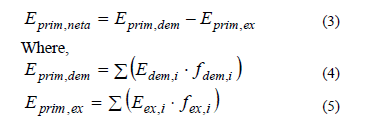
Where  is the energy delivered by the power grid
is the energy delivered by the power grid  ,
,  is energy exported to the power grid
is energy exported to the power grid  ,
,  is the primary energy factor for electricity supplied by the grid
is the primary energy factor for electricity supplied by the grid 
and  is the primary energy factor for energy exported to the power grid
is the primary energy factor for energy exported to the power grid  .
.
The electrical energy generated and consumed could not be calculated as shown in Equation (1) and Equation (2) because the primary energy associated did not only come from electricity, but also from other energy sources such as natural gas or wood.
The conversion factors are linked to the type of energy and power that is supplied. In Table 3 type values taken from [35,36] can be observed
2.1.3. Carbon emissions
With this indicator it is intended that the system exports as much free energy emissions so as to offset the amount of emissions produced by the amount of energy required. The mass of CO2 is calculated from the energy demand ( ) and exported energy (
) and exported energy ( ) for each grid, as shown in (6).
) for each grid, as shown in (6).

Where  is the emission coefficient CO2 to the energy delivered by the grid
is the emission coefficient CO2 to the energy delivered by the grid  , and
, and  is the emission coefficient CO2 or energy exported to the energy grid
is the emission coefficient CO2 or energy exported to the energy grid  .
.  and
and  will always be of equal value if there is only one energy supply system regardless of the on-site generation. The coefficients for calculation of emissions CO2 are presented in Table 3.
will always be of equal value if there is only one energy supply system regardless of the on-site generation. The coefficients for calculation of emissions CO2 are presented in Table 3.
2.1.4. Energy cost
With this indicator it is intended that the system, at the end of each period, has a net cost  equal to zero [33]. This can be calculated as described in Equation (7).
equal to zero [33]. This can be calculated as described in Equation (7).

Where  is the energy cost delivered by the grid
is the energy cost delivered by the grid  and
and  is the cost for energy exported to the electricity grid
is the cost for energy exported to the electricity grid .
.
The costs of both, export and demand energy, are determined by the entity that governs the energy price in each country, if they are equal the balance would be the case of the power indicator.
2.2. Base configurations
The NZEB are classified into on-grid and off-grid according to the interconnection or not the grid [29]. For the case of off-grid NZEB energy consumption must be supplied by the generation site, which describes its permanent condition balance.
According to [12,16,34,37-40], it could be possible to consider the connection to the supply grid as an energy storage system because of the bidirectional flow of energy, so the addition of batteries would not be required.
Fig. 3 shows three basic configurations of building's operation constructed under the NZE concept.
The advantages and disadvantages of each form of connection are shown in Table 4.
3. Technical aspects that have influence on the energy performance of a social dwelling, considering the variety of thermal levels in Colombia
The residential electricity demand in Colombia depends of sociocultural, socioeconomic, political, climatic (variety of thermal levels) [41] and geographic [42] factors, among others. Those factors characterize the electricity demand in homes, and so they have influence on the design of energy efficient systems.
3.1. Energy performance of the residential sector in Colombia
The analysis of the energy performance of a house located in Colombia should take into consideration factors for residential energy design, such as socioeconomic strata.
3.1.1. Social dwelling location according to the socio-economic strata
Currently, in Colombia the residential property is classified in six socioeconomic strata: low-low (1), low (2), medium-low (3), medium (4), medium-high (5) and high (6) [43].
The VIS and VIP are buildings designed to guarantee the right to dwelling for low-income families, which are localized primarily in strata 1, 2 and 3, and have subsidised public services [44]. It is worthwhile mentioning that these strata have the major percentage of country's inhabitants (87%) as can be determined in the Fig. 4.
However, it must be taken into account that the VIS are intended for people who have a monthly income less than 4 SMMLV and are not allocated according to socioeconomic strata [2], although there is a correlation.
Therefore, Table 5 shows the average monthly income per home in dollars and pesos according to each specific strata and many SMMLV equivalent monthly income per home. This projection was made with the income values found in [46] for 2008 and with the consumer price index found in [47] for 2012.
According to Table 5, it is possible to observe that the candidate homes to the VIS are located primarily in strata 1 and 2.
3.1.2. Behavior of the electricity demand according to the possible strata where the VIS are located
Once identified, the strata where the VIS could possibly be located and the behavior of the energy demand following the residential sector per strata in the country is described.
Fig. 5 shows the annual electricity consumption per strata and the percentage of the total consumption (23 748.04 GWh/year). This shows that the total demand of about 85% is consumed in the low-low, low and medium-low strata.
Furthermore, Fig. 6 shows the average monthly consumption per user for each stratum. The heighest and lowest consumption are in two and six strata, respectively.
3.1.3. Thermal levels influence the potential electrical appliances that are customizable in Colombia
Colombia is located in a tropical area, therefore it has significant solar radiation throughout the year; moreover, it has a high relief characteristic from the Andes mountain range, for this reason altitude is a meaningful climatic factor that gives rise to thermal levels [52].
Fig. 7 shows the thermal levels associated with the temperature range and the elevation above sea level. Some Colombian cities are also given as examples with their corresponding altitude and temperature values.
3.1.4. Thermal levels classification with the identification of the potential electrical appliances in VIS
In Colombia, the climatic diversity found in the same country makes it difficult to classify the climates [52]. It is easier to do so therefore by municipality.
Thus, to represent the several scenarios of climatological and energy behavior, five cities were selected based on three aspects:
- Prinicple cities where the operation areas that are managed by the meteorological inspection, measurement and vigilance system of the IDEAM are localized.
- From the cities found in [52], five have the highest number of families with electricity availability according to the DANE [47]: Bogotá, Medellin, Cali, Barranquilla and Bucaramanga.
- Last, the thermal levels of the chosen cities is also relevant.
Fig. 8 shows the average temperature for each one of the selected cities, where the cities can be classified to be in a specific thermal level considering the information given in Fig. 7. Barranquilla and Cali fall under the hot climate category, Medellin and Bucaramanga the mild climate and Bogotá the cold climate.
Once the chosen cities have been classified in their different thermal levesl, it is possible to identify the energy appliances that have a relevant usability in the house.
Fig. 9 shows the percentage of the housing for Bogota, the Atlántico region (Guajira, Cesar, Magdalena, Atlántico, Bolívar, Sucre y Córdoba) and the Antioquia Department, which, in 2012, bought some kind of electrical appliance or household gas. These three ares represent the cold climate, mild climate and hot climate, respectively.
The need to climatize the house environment, in hot and mild climates like the Atlántico region and the Antioquia department, making use of the fans and air conditioning is relevant. Also, the domestic hot water use in cold and mild climates like Bogota and the Antioquia department, respectively is important.
In the identification of the potential implementation energy appliances for the different thermal levels in NZE homes, the methodology used is given in [40,54-59]. Such a methodology begins with the reduction of the energy demand through passive building design, and takes into account the energy efficiency of the increase in number of appliances and rational use of the energy, and lastly the micro generation systems are identified from renewable energies adaptable to the house.
3.2. Recommendations for low energy consumption with use of passive appliances and energy efficient systems
The recommendations are given taking into the account the passive and active energy appliances that could be adaptable in a social dwelling, highlighting those that are frequently used according to the thermal level, as it is shown in Fig. 9.
3.2.1. Construction materials
The construction materials have to include renewables, the production of which emits low amounts of CO2to the atmosphere. Table 6 describes the materials that are considered more adequate for social dwelling construction in terms of thermal inertia and their adaptability in the different climates [60].
The regional materials have a manufacturing process that has been transmitted from one generation to the next, and modern materials are industrialized. When the materials have a high thermal inertia, and maintain a stable temperature, they take a long time to let the heat pass to the building inside and they are recommended for cold and mild climates, acquiring the heat in the morning which is then conducted into the dwelling in the night.
If material has a low thermal inertia the time is short, which is recommended in hot climates because avoiding the heat gain is required [60]. Also, the house has thermal insulation in walls, floors, windows and roofs (green roofs) and can use eaves, blinds, cantilevers and shadows to avoid the solar gain in hot climates.
3.2.2. Strategic orientation and location
For mild and hot climates, it is recommended that the facade orientation is in a NORTH-SOUTH direction and located such a way that it is protected from the sun and exposed to the cold winds. In the cold climate the façade must be in NORTHEAST-SOUTHEAST or EAST-WEST direction and located in such a way that it is exposed to the sun and protected from the cold winds [60].
3.2.3. Natural ventilation and lighting
As a passive technique, significant window areas are typically installed to facilitate the airflow through the housing, which is designed so that there is natural cross ventilation.
For natural lighting the passive techniques that can be used are, solar tubes [39], skylights [61], low-growing trees that allow light in the house, and large areas of windows.
3.2.4. Energy efficient systems on a VIS
The housing design must reduce energy consumption by replacing the conventional systems using high-efficiency systems. Table 7 compares the two systems that may be used in a dwelling.
3.3. Energy generation in situ
To implement an energy generation system, the energy supply, project scale and sector of the economy to which it is directed must be considered. Table 8 highlights the power generation according to the generation and obtaining resources site.
In Table 9, according to the installed capacity the generation systems are classified depending on the scale, residential or industrial application and the way that energy is supplied. It is important to observe that the photovoltaic wind generation systems can be adapted to the residential level, according to the installed capacity; however, it depends on the wind speed and the solar radiation in generation place.
Generally, Colombia shows a monthly average global solar radiation uniformly throughout the year approximately from 4,0 kWh/m2 to 4,5 kWh/m2: this being the largest spatial distribution. However, some areas are outstanding, as Table 10 shows.
Typically, solar energy has three technology trends, photovoltaic, thermal and passive [63], these being easily implemented in residential areas, as seen in Fig. 10.
3.3.1. Photovoltaic energy
This application is based on the photovoltaic panels, placed strategically to capture solar radiation. The systems most used are shown in Fig. 11.
3.3.2. Solar thermal energy
Solar thermal energy is mainly used in homes as a source of heat for space conditioning through the use of radiant floors and the usability of domestic swimming pools and hot water [64]. Additionally it has other uses according to the temperature required, as seen in Fig. 12.
3.3.3. Wind energy
Colombian winds are mainly located on the peninsula of La Guajira, and are among the best in South America for wind power generation, reaching speeds of around 10 m/s.
According to [65], the annual wind power density of 20 meters high has values of 216 W/m2 and 343 W/m2 for areas in the Departments of La Guajira, Atlántico and between Quindío and Tolima.
Also, in some areas in the Department of La Guajira wind density values can be achieved of between 343 W/m2 and 729 W/m2. It is important to highlight that for heigher altitudes and different times of the year the energy densities can increase considerably; however, the wind resource is sectored in Colombia and not all regions enjoy wind speeds suitable for generation.
4. Case study
In [66] a database with information of about 300 Net Zero Energy building case studies is shown. They are distributed around the world and as shown in Fig. 13.
In Fig. 14 is possible to see a ranking of NZEB cases found in [67], depending on the climate and Fig.15 for different types of construction.
Moreover, 42 case studies were compiled and classified to identify the most used active and passive appliances, technologies and generation technologies.
According to Fig. 16, the passive appliance that has the most use in NZEB is thermal insulation, stating that 84% of the buildings studied were applying.
Also, is noteworthy to mention the implementation of passive techniques such as the use of sustainable materials, natural lighting and ventilation, which are used in more than half of the buildings. Moreover, it is possible to see that the strategic orientation is an application that is not used very often in this type of construction.
Fig. 17 shows that the frequency of the use of active and eficient appliances in the buildings is high, especially the use of heating systems due the majority of reported cases being located in countries with seasonal climate variability.
Fig. 18 showns how the use of generation systems and solar energy to produce heat or electricity has great reception in NZEB; however, the use of wind energy and other technologies for on-site generation is still very poor.
5. Conclusions
The concept of NZE homes involves the covering of basic energy consumption needs that occur in residential buildings, using highly efficient energy applications. Homes around the world have been able to reduce their energy consumption in a way that no resident comfort was lost, thanks to new technologies developed to cover the basic needs in these homes.
A building can achieve NZE energy balance being off-grid, but this type of housing requires a large autonomous investment due to the cost of energy storage systems. Therefore, internationally, on-grid type buildings are preferred and autonomous housing design is performed for non-interconnected areas that have difficult access to supply networks.
In on-grid NZE buildings the bi-directionality in the energy grids has a great weight requirement when we want to produce balance compensation, because energy injection into the grid is required.
In buildings that are NZE designed under the methodology cost, ZEB will be always necessary to ensure that payment is made for the energy that is exported to the network. This is because it could only produce a balance in this way. The NZE concept applied in social dwellings could generate a very positive impact on the society and the environment. This can be seen through the analysis made about the behavior of the country's energy demands according to the socioeconomic strata. It was possible to infer that the homes applying to become social dwelling are found primarily in strata one and two, and the major residential energy demand is from the same strata. This generates a reduction in the energy consumption in the residential sector and in the low strata.
The influence of the thermal levels on consumption of energy of electrical appliances that are used in the home have a substantial impact since they cause an increase or decrease energy demand. Thus, it can be known what kind of appliances have a major energy demand when the thermal levels vary for each place, as well as how they could be replaced by other more efficient appliance, considering those with more frequent use than could meet the basic needs of social dwellings.
In the residential sector, the utilization of solar resources in energy generation through the use of photovoltaic panels and solar collectors has great utility. Colombia enjoys this resource in abundant quantities; therefore, encouraging energy generation on-site and fulfilling one of the main features of a NZE home, energy generation using renewable sources for energy demand compensation should be encouraged. In the NZE home design is important to establish the NZEB concept you wish to operate and the type of balance to be achieved, giving way to correct sizing of efficient energy systems and alternative energy source that best suits the place. Also, it is very important to design a home that is financially feasible and especially oriented to the social dwellings.
Based on the case studies mentioned, it is possible to see that regardless of the type of NZEB, the implementation of solar energy (photovoltaic and thermal) is better than wind energy and biomass for energy generation on-site. It is also clear that the use of the design concept in NZE buildings located in Latin America is very poor, as in this database there were only two cases found: one in Argentina and one in Costa Rica.
References
[1] Secretaria de Planeación Departamental del Valle del Cauca and Gobernación del Valle del Cauca, Vivienda de interés social en el Valle del Cauca. Normas e instrumentos de gestión. 2011, pp. 1-57. [ Links ]
[2] Ministerio de Ambiente Vivienda y Desarrollo Territorial, Procedimientos en vivienda de interés social, Serie Guías de Asistencia Técnica para Vivienda de Interés Social, vol. 4, pp. 1-73, 2011. [ Links ]
[3] Pless, S. and Torcellini, P., Net-Zero energy buildings: A classification system based on renewable energy supply options, National Renewable Energy Laboratory, June, pp. 1-14, 2010. [ Links ]
[4] Gangolells, M., Casals, M., Gassó, S., Forcada, N., Roca, X. and Fuertes, A., A methodology for predicting the severity of environmental impacts related to the construction process of residential buildings, Building and Environment, 44 (3), pp. 558-571, 2009. DOI: 10.1016/j.buildenv.2008.05.001 [ Links ]
[5] Yudelson, J., Green building A to Z. Understanding the lenguage of green building. New Society Publishers, 2007, 241 P. [ Links ]
[6] Paul, W.L. and Taylor, P.A., A comparison of occupant comfort and satisfaction between a green building and a conventional building, Building and Environment, 43 (11), pp. 1858-1870, 2008. DOI: 10.1016/j.buildenv.2007.11.006 [ Links ]
[7] Wang, Z., Wang, L., Dounis, A.I. and Yang, R., Multi-agent control system with information fusion based comfort model for smart buildings, Applied Energy, 99, pp. 247-254, 2012. DOI: 10.1016/j.apenergy.2012.05.020 [ Links ]
[8] Malet-Damour, B., Garde, F., David, M. and Prasad, D., Impact of the Climate on the design of low-energy buildings for Australia and Reunion Island, 12th Conference of International Building Performance Simulation Association, Proceedings of Building Simulation, pp. 2867-2873, 2011. [ Links ]
[9] Rodrigues, L.T., Gillott, M. and Tetlow, D., Summer overheating potential in a low-energy steel frame house in future climate scenarios, Sustainable Cities and Society, 7, pp. 1-15, 2013. DOI: 10.1016/j.scs.2012.03.004 [ Links ]
[10] Cooper, P., Liu, X., Kosasih, P.B. and Yan, R., Modelling net zero energy options for a sustainable buildings research centre, 12th Conference of International Building Performance Simulation Association, Sydney, Proceedings of Building Simulation, pp. 2799- 2086, 2011. [ Links ]
[11] Abdalla, G., Maas, G.E.R. and Huyghe, J., Barriers to Zero Energy Construction (ZEC) technically possible, Why not succeed yet?, PLEA 2009 - 26th Conference on Passive and Low Energy Architecture, Quebec City, Canada, June, pp. 1-3, 2009. [ Links ]
[12] Torcellini, P., Pless, S., Deru, M. and Crawley, D., Zero energy buildings: A critical look at the definition, National Renewable Energy Laboratory, U.S Department of Energy, pp. 1-12, 2006. [ Links ]
[13] Miller W., and Buys, L., Anatomy of a sub-tropical Positive Energy Home (PEH), Solar Energy, 86 (1), pp. 231-241, 2012. DOI: 10.1016/j.solener.2011.09.028 [ Links ]
[14] Lenoir, A., Thellier, F. and Garde, F., Towards Net Zero Energy buildings in hot climate, Part 2: Experimental feedback, ASHRAE Transactions, 117, pp. 1-8, 2011. [ Links ]
[15] Attia, S. and De Herde, A., Defining zero energy buildings from a cradle to cradle approach, PLEA 2011 - 27th Conference on Passive and Low Energy Architecture, July, pp. 205-210, 2011. [ Links ]
[16] Kolokotsa, D., Rovas, D., Kosmatopoulos, E. and Kalaitzakis, K., A roadmap towards intelligent net zero- and positive-energy buildings, Solar Energy, 85 (12), pp. 3067-3084, 2011. DOI: 10.1016/j.solener.2010.09.001 [ Links ]
[17] Bojić, M., Nikolić, N., Nikolić, D., Skerlić, J. and Miletić, I., Toward a positive-net-energy residential building in Serbian conditions, Applied Energy, 88 (7), pp. 2407-2419, 2011. DOI: 10.1016/j.apenergy.2011.01.011 [ Links ]
[18] Gilijamse, W., Zero-Energy house in the Netherlands building performance, IBSA, Madison, Wisconsin, pp. 276-283, 1995. [ Links ]
[19] Iqbal, M.T., A feasibility study of a zero energy home in Newfoundland, Renewable Energy, 29 (2), pp. 277-289, 2004. DOI: 10.1016/S0960-1481(03)00192-7 [ Links ]
[20] European Parliament and the Council of the European Union, Energy performance of buildings. Legislative resolution, Officiial Journal of the European Union, April, pp. 263-291, 2009. [ Links ]
[21] Hernandez, P. and Kenny, P., From net energy to zero energy buildings: Defining life cycle zero energy buildings (LC-ZEB), Energy and Buildings, 42 (6), pp. 815-821, 2010. DOI: 10.1016/j.enbuild.2009.12.001 [ Links ]
[22] Marszal, A.J. and Heiselberg, P., Life cycle cost analysis of a multi-storey residential net zero energy building in Denmark, Energy, 36 (9), pp. 5600-5609, 2011. DOI: 10.1016/j.energy.2011.07.010 [ Links ]
[23] Srinivasan, R.S., Braham, W.W., Campbell, D.E. and Curcija, C.D., Re(De)fining net zero energy: Renewable emergy balance in environmental building design, Building and Environment, 47, pp. 300-315, 2012. DOI: 10.1016/j.buildenv.2011.07.010 [ Links ]
[24] Vale, R.V.B., The new autonomus house: Design and planning for sustainibility. Thames & Hudson, 2002, pp. 1-256. [ Links ]
[25] Thiers, S. and Peuportier, B., Energy and environmental assessment of two high energy performance residential buildings, Building and Environment, 51, pp. 276-284, 2012. DOI: 10.1016/j.buildenv.2011.11.018 [ Links ]
[26] Atanasiu, B., Ecofys Germany GmbH, and Danish Building Research Institute (SBi), principles for nearly zero-energy buildings. Paving the way for effective implementation of policy requirements. Building Performance Institute Europe (BPIE), 2011, pp. 1-99. [ Links ]
[27] Kurnitski, J., Allard, F., Braham, D., Goeders, G., Heiselberg, P., Jagemar, L., Kosonen, R., Lebrun, J., Mazzarella, L., Railio, J., Seppänen, O., Schmidt, M. and Virta, M., How to define nearly net zero energy buildings nZEB. REHVA, Federation of European Heating, Ventilation and Air-conditioning Associations, pp. 1-18, 2012. [ Links ]
[28] Booth, S., Barnett, J., Burman, K., Hambrick, J. and Westby, R., Net zero energy military installations: A guide to assessment and planning, National Renewable Energy Laboratory, pp. 1-48, 2010. DOI: 10.2172/986668 [ Links ]
[29] Marszal, A.J. and Heiselberg, P., A literature review of Zero Energy Buildings (ZEB ) definitions, 2009. [ Links ]
[30] Sartori, I., Napolitano, A. and Voss, K., Net zero energy buildings: A consistent definition framework, Energy and Buildings, 48, pp. 220-232, 2012. DOI: 10.1016/j.enbuild.2012.01.032 [ Links ]
[31] Marszal, A.J., Life cycle cost optimization of a BOLIG + Zero Energy Building, in Aalborg University, Denmark, 2012, pp. 1-57. [ Links ]
[32] Carlisle, N., Geet, O.V. and Pless, S., Definition of a 'Zero Net Energy' community, National Renewable Energy Laboratory, November, pp. 1-14, 2009. [ Links ]
[33] Kurnitski, J., Saari, A., Kalamees, T., Vuolle, M., Niemelä, J. and Tark, T., Cost optimal and nearly zero (nZEB) energy performance calculations for residential buildings with REHVA definition for nZEB national implementation, Energy and Buildings, 43 (11), pp. 3279-3288, 2011. DOI: 10.1016/j.enbuild.2011.08.033 [ Links ]
[34] Marszal, A.J., Heiselberg, P., Bourrelle, J.S., Musall, E., Voss, K., Sartori, I. and Napolitano, A., Zero Energy Building - A review of definitions and calculation methodologies, Energy and Buildings, 43 (4), pp. 971979, 2011. DOI: 10.1016/j.enbuild.2010.12.022 [ Links ]
[35] European Comission and European Free Trade Association, Energy performance of buildings - Overall energy use, CO2 emissions and definition of energy ratings, European Standard, pp. 1-45, 2006. [ Links ]
[36] Deutsches Institut für Normung (DIN), Energy efficiency of buildings - Calculation of the energy needs, delivered energy and primary energy for heating, cooling, ventilation, domestic hot water and lighting - Part 1: General balancing procedures, terms and definitions, zoning and evalu, pp. 1-66, 2007. [ Links ]
[37] Salvador, M. and Grieu, S., Methodology for the design of energy production and storage systems in buildings: Minimization of the energy impact on the electricity grid, Energy and Buildings, 47, pp. 659-673, 2012. DOI: 10.1016/j.enbuild.2012.01.006 [ Links ]
[38] Voss, K., Musall, E. and Lichtmeb, M., From low-energy to net zero- energy buildings: status and perspectives, Journal of Green Building, 6 (1), pp. 46-57, 2011. DOI: 10.3992/jgb.6.1.46 [ Links ]
[39] Kılkış, Ş. ,A net-zero building application and its role in exergy-aware local energy strategies for sustainability, Energy Conversion and Management, 63, pp. 208-217, 2012. DOI: 10.1016/j.enconman.2012.02.029 [ Links ]
[40] Fong, K.F. and Lee, C.K., Towards net zero energy design for low-rise residential buildings in subtropical Hong Kong, Applied Energy, 93, pp. 686-694, 2012. DOI: 10.1016/j.apenergy.2012.01.006 [ Links ]
[41] Ministerio de Minas y Energía, Memorias al Congreso de la República. Sector Energía Eléctrica, 2010. [ Links ]
[42] Ramos-Niembro, G., Fiscal, R., Maqueda, M., Sada, J. and Buitrón, H., Variables que influyen en el consumo de energía eléctrica. México, Aplicaciones tecnológicas, pp. 11-18, 1999. [ Links ]
[43] Congreso de la República de Colombia, Ley 689 / 2001 Modificatoria Ley 142 / 1994. El régimen tarifario de las empresas de servicios públicos, artículo 16.," 2001. [Online]. [Accessed: 02-Jun- 2013]. Available at: http://www.ccconsumidores.org.co/index.php?option=com_content&view=section&layout=blog&id=8&Itemid=126. [ Links ]
[44] Consejo Nacional de Política Económica y Social, Plan de acción para la focalización de los subsidios para servicios públicos domiciliarios. Documento Conpes, República de Colombia, Departamento Nacional de Planeación, pp. 1-30, 2005. [ Links ]
[45] DANE, Proyección de población, 2012. [Online]. [Accessed: 03-Jul-2013]. Available at: http://www.dane.gov.co/index.php?option=com_content&view=article &id=75&Itemid=72. [ Links ]
[46] Ministerios de Comunicaciones. República de Colombia, Resumen ejecutivo. Impacto socioeconómico de la implementación de la televisión digital terrestre en Colombia. pp. 1-17, 2008. [ Links ]
[47] DANE, Censo general, 2005. [Online]. [Accessed: 02-Jun-2013]. Available at: http://www.dane.gov.co/index.php?option=com_content&view=article &id=307&Itemid=124. [ Links ]
[48] Ministerio de Trabajo, Salario minimo mensual legal vigente, 2012. [Online]. [Accessed: 02- Jun-2013] Available: http://www.mintrabajo.gov.co/ [ Links ]
[49] Banco de la República de Colombia, Serie histórica empalmada de datos. Promedio anual, 2012. [Online]. Available at: http://www.banrep.gov.co/es/-estadisticas. [Accessed: 02-Jun-2013] [ Links ].
[50] Sistema Único de Información de Servicios Públicos, Consolidado de energía por empresa y departamento. [Online]. Available: http://reportes.sui.gov.co/reportes/SUI_ReporteEnergia.htm. [Accessed: 02-Jun-2013] [ Links ].
[51] XM S.A. E.S.P, Comportamiento de la demanda de energía eléctrica, 2012. [Online]. [Accessed: 02-Jun-2013]. Available at: https://www.xm.com.co/Pages/Home.aspx. [ Links ]
[52] Instituto de Hidrología Meteorología y Estudios Ambientales, Atlas Climatológico Nacional. 2005, pp. 1-184. [ Links ]
[53] DANE, Encuesta Nacional de Calidad de Vida, 2012. [Online]. [Accessed: 02-Jun-2012]. Available at: http://www.dane.gov.co/index.php?option=com_content&view=article &id=2314&Itemid=66. [ Links ]
[54] Bessoudo, M., Mcminn, J., Theaker, I. and Webber, D., Approaching Net-Zero Energy, Canadian Architect, pp. 28-31, 2011. [ Links ]
[55] Charron, R. and Athienitis, A., Design and optimization of net zero energy solar homes, ASHRAE Transactions, 112 (2), pp. 285-296, 2006. [ Links ]
[56] Laws, J., Getting to zero, Occupational health & safety (Waco, Tex.), 81 (1), pp. 32-34, 2012. [ Links ]
[57] Proskiw, G. and Proskiw Engineering Ltd, Identifying affordable net zero energy housing solutions, 2010. [ Links ]
[58] Hoque, S., Net zero energy homes: An evaluation of two homes in the northeastern United States, Journal of Green Building, 5 (2), pp. 79-90, 2007. DOI: 10.3992/jgb.5.2.79 [ Links ]
[59] Attia, S., Hamdy, M., O'Brien, W. and Carlucci, S., Assessing gaps and needs for integrating building performance optimization tools in net zero energy buildings design, Energy and Buildings, 60, pp. 110- 124, 2013. DOI: 10.1016/j.enbuild.2013.01.016 [ Links ]
[60] Ministerio de Ambiente Vivienda y Desarrollo Territorial, Los materiales en la construcción de vivienda de interés social, Serie Guías de Asistencia Técnica para Vivienda de Interés Social, vol. 2, pp. 1-42, 2011. [ Links ]
[61] Panao, M.J.N.O. and Gonçalves, H.J.P., Solar XXI building: Proof of concept or a concept to be proved?, Renewable Energy, 36 (10), pp. 2703-2710, 2011. DOI: 10.1016/j.renene.2011.03.002 [ Links ]
[62] Unidad de Planeación Minero Energética and IDEAM, Mapas de radiación solar global sobre una superficie plana, in Atlas de Radiación Solar de Colombia, 2005, pp. 25-40. [ Links ]
[63] Instituto de Tecnología y Formación, en: Méndez-Muñiz, J.M. and Cuervo-García, R., Energía solar fotovoltaica, Segunda ed. FC Editorial, 2005, pp. 1-245. [ Links ]
[64] Perales-Benito, T., Instalación de paneles solares térmicos, Cuarta Ed. Creaciones Copyright, 2007, pp. 1-146. [ Links ]
[65] Unidad de Planeación Minero Energética and IDEAM, Densidad de energía eólica a 20 y 50 metros de altura, in Atlas de Viento y Energía Eólica en Colombia, 2006, pp. 75-102. [ Links ]
[66] Reserch for Energy Optimized Building, Net zero energy builging - map of international project." [Online]. [Accessed: 21-Jul-2013] Available at: http://www.enob.info/en/net-zero-energy-buildings/map/. [ Links ]
[67] Aalborg University, NZEB Demonstration Buildings, International Conference Towards Net Zero Energy Buildings. [Online]. [Accessed: 02-Jun-2013]. Available at: www.zeb.aau.dk. [ Links ]
G.A. Osma-Pinto, received his BSc. in Electrical and Industrial Engineering in 2007, and his MSc. in Electrical Engineering in 2011 from the Universidad Industrial de Santander (UIS), Bucaramanga, Colombia. Currently he is a PhD(c) in this university and a researcher in the School of Electrical Engineering at UIS. His research interests include: green buildings, energy application, automation, exergy, and micro-grids.
D.A. Sarmiento-Nova, received his BSc. degree in Electrical Engineering in 2013, from the Universidad Industrial de Santander, Bucaramanga, Colombia. Currently he is a MSc. student in the School of Electrical and Computer Engineering in the University of Campinas - UNICAMP, Brasil.
N. C. Barbosa-Calderón, received her BSc. degree in Electrical Engineering in 2013, from the Universidad Industrial de Santander, Bucaramanga, Colombia. Since 2013 she has been working as an Electrical Engineer in the oil sector, focusing mainly in the areas of quality and engineering. She has worked as contractor for companies like Ecopetrol and Occidental Andina, OXY.
G. Ordóñez-Plata, received his BSc. in Electrical Engineering from the Universidad Industrial de Santander (UIS), Bucaramanga, Colombia, in 1985. He received his PhD in Industrial Engineering from the Universidad Pontificia Comillas, Madrid, Spain, in 1993. Currently, he is professor in the School of Electrical Engineering at the Universidad Industrial de Santander (UIS-Colombia). His research interests include: Electrical Measurements, Power Quality, Smart Grids, Smart Metering, and Education based on competences.













